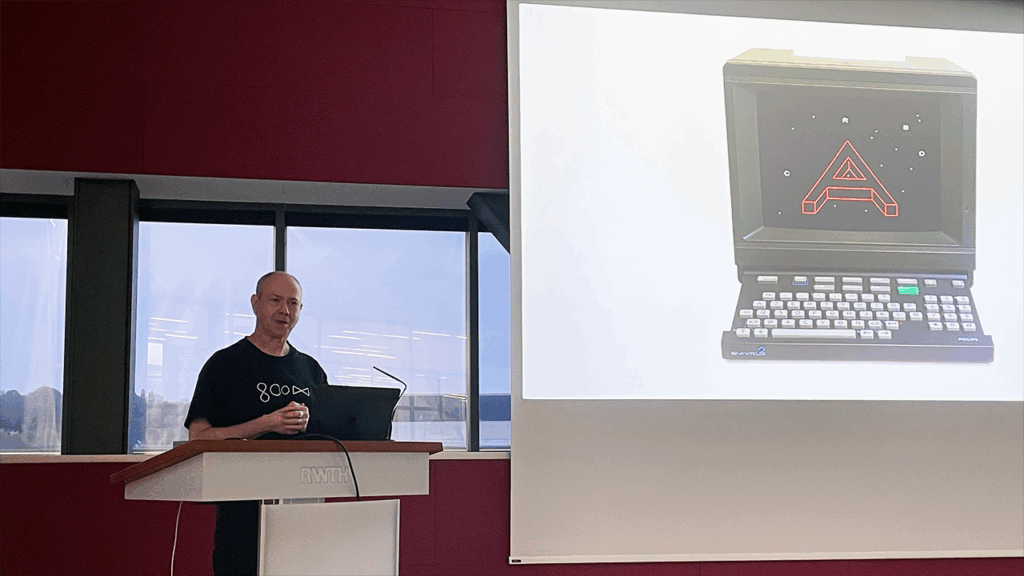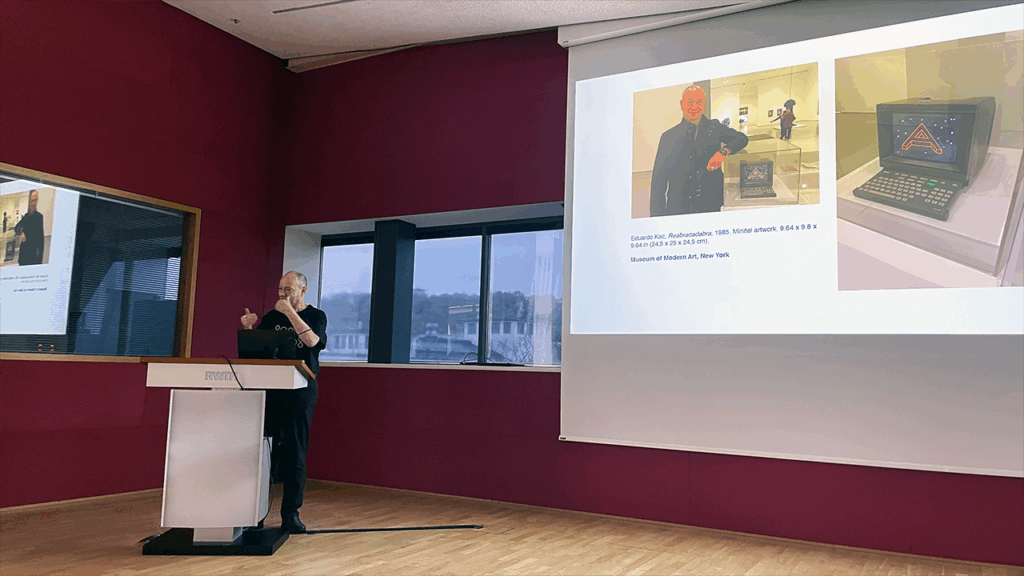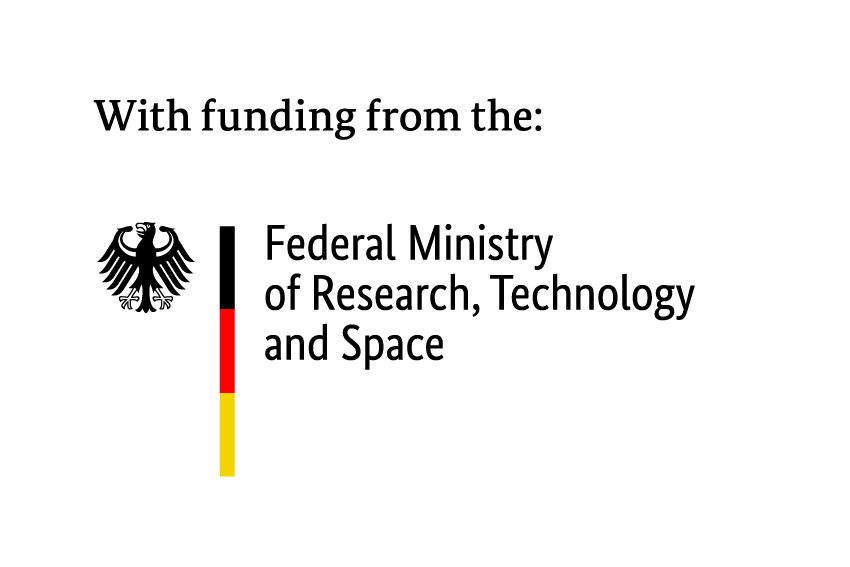ARIANNA BORRELLI
The workshop “After Networks: Reframing Scale, Reimagining Connections”, organized by c:o/re Fellow Nathalia Lavigne, took as its starting point the increasing critiques to digital platforms as monopolizing and shaping networking according to economic interests, and so leading to a crisis of social interactions.
A key question at the meeting was whether and how artistic activities can help (re)imagine connections beyond digital social media, and artist Eduardo Kac was invited to present and reflect his work in this perspective. Given the critical stance of the workshop towards new technologies, Kac could at first appear as a strange choice, since his artworks, while of extremely diverse nature, all made use of what were at the time cutting-edge technologies, from early computer networks to space travel. Can we use technology to reach beyond Big-Tech-dominated networks? Let us seek the answer in Kac’s works as he presented them at the c:o/re event.
Eduardo Kac created his first artworks in Brazil in the early 1980s by manipulating the pixels on a computer screen, and had to work hard to have the results accepted as an art piece for an exhibit. Later, he artistically explored one of the first computer network: the French Minitel. In the 1980s, the French government had decided to kick-start one of the first forms of a nation-wide digital information network. Minitels were not personal computers, but videotex terminals with screen and keyboard: they could be loaned for free from the Post offices, plugged into the telephone network and so enabled to send or request information, access bulletin boards, book tickets, buy products – or view four works by Kac.
At the event, the artist showed us on a large screen an example of what the users would have seen on their Minitel viewer. In the work “Reabracadabra” (1985) colored lines slowly drew themselves from top down on the screen, and eventually became recognizable as the letter A, surrounded by small letters forming the word abracadabra. Even though Kac had shown us before a picture of the finished image, seeing it slowly emerge from the dark screen with a simple, but fluid motion was somehow surprising, as the effect was quite different form today’s digital imaging. Like all information received through the Minitel, the artwork could not be stored locally, and disappeared when the screen was cleared. In other words, the art existed in the connection, and only as long as the connection itself was there. Indeed, the original artworks disappeared for good when the French government finally switched off the Minitel network, but Kac had already been active to recover and reconstruct them, and so they could be displayed on original Minitel terminals at the exhibition “Electric Dreams. Art and Technology Before the Internet” (Tate Modern, London 28/11/24-1/6/25). Thus, the work also explores questions of the limits of archiving digital artworks, and lets us wonder how far a recreated network can support the “same” artwork.

During the 1990s, the internet became a global phenomenon, but in the meantime Kac had become active in another technological outreach: biotechnologies. Other than the Minitel artworks, Kac’s creations in this field are quite well-known, especially the GFP Bunny (2000), a genetically engineered rabbit which glows in the dark. Its presentation gave rise to broad and intense media reactions which surprised its author and prompted him to embed them in new artworks. Kac pointed out that the pop-culture reaction to his work gave him the opportunity of opening a communication channel, where he would send implicit messages to companies, television shows and other agents quoting his work. This communication channel was a way to create networks via implicit messages, where the media is the globality of media and the artwork becomes the medium enabling communication. Kac also presented another example of art involving non-human life forms: “Essay Concerning Human Understanding” (1994), in which a bird and a plant are enabled to communicate in a bio-technological environment and so generate art for each other. Here, technology and human actors become a network for the creation and consumption of art on the part of non-human creatures.

The final works Kac discussed at the workshop turned to yet another cutting-edge technology: space travel. With the cooperation of NASA since the early Noughties, Kac placed artworks in space, and one of them, a cubic, laser-engraved glass sculpture named “Adsum”, lies today in the Mare Crisium, a crater on the Moon’s face always visible from Earth. Yet these are “only” earthly artworks placed in space: the next creation Kac showed us in his presentation was an artwork produced in space to be consumed in space. “Inner Telescope“ is a technologically minimal creation made out of two standard sheet of paper by using only the bare hands and a pair of scissors. The hands were not those of the artist, though, but of French astronaut Thomas Pesquet who, following Kac’s instructions, produced the artwork during his stay in the International Space Station (ISS) in 2017. Looking like an M pierced by a tube, the work on Earth would only clumsily and formlessly slump onto a surface, but under zero gravity it floats lightly against the backdrop of the earthly blue marble: the first native outer space artwork. Who is the artist here: Kac, the astronaut, the zero gravity environment – or maybe NASA? Clearly, this question makes little sense, as the work highlights what was already implicit in the previous ones, namely the number factors and actors which combine to produce a work of art, blurring the distinction between creators and consumers, and letting them all appear as nodes in a live artistic network. Kac’s creative impulse takes the role of an enabler, setting up a bio-physical-technological network and artwork.
Let us now go back to the initial question: Can we use technology to reach beyond Big-Tech-dominated networks? Kac’s works show that this may be possible by highlighting how artworks, however technologically based, are never made out of technology, but of the situated entities communicating through it, be they humans on earth or space, animals or plants, or paper floating in space. In a similar way, we might go beyond today’s social networks not by rejecting them, but by becoming aware that their digital technology does not constitute a new, magical network for us to live in, but is only an additional factor enabling life forms in the universe to live out their inner potential for connection. We are the network, if we so imagine ourselves.



